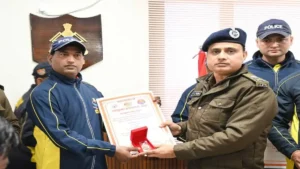In a significant recognition of efforts to combat air pollution, the Union Environment Ministry has presented the “National Clean Air City” Awards during the Swachh Vayu Survekshan 2024. This event, held as part of a national workshop celebrating the “International Day of Clean Air for Blue Skies” in Jaipur on Saturday, showcased the remarkable strides made by various Indian cities in improving their air quality.
Top Performers: A City-wise Breakdown
The awards were categorized based on population size, acknowledging the unique challenges and achievements of cities across different scales.
Major Cities (Population over 10 lakh)
- Surat, Gujarat: Emerged as the top major city in India for air quality improvements
- Jabalpur, Madhya Pradesh: Secured the second position
- Agra, Uttar Pradesh: Ranked third among large cities
Medium-sized Cities (Population between 3 lakh and 10 lakh)
- Firozabad, Uttar Pradesh
- Amravati, Maharashtra
- Jhansi, Uttar Pradesh
These cities were recognized for their significant efforts in implementing air quality improvement measures.
Smaller Cities (Population under 3 lakh)
- Raebareli, Uttar Pradesh
- Nalgonda, Telangana
- Nalagarh, Himachal Pradesh
The inclusion of smaller cities in the awards highlights the importance of air quality management across all urban scales in India.
Understanding the Swachh Vayu Survekshan
The “Swachh Vayu Survekshan” is a pioneering initiative by the Ministry of Environment, Forest and Climate Change. Its primary objectives include:
- Ranking cities based on the implementation of activities approved under their respective city action plans
- Assessing air quality improvements in cities covered under the National Clean Air Programme (NCAP)
This surveying and ranking system serves as a crucial tool for:
- Encouraging healthy competition among cities
- Promoting best practices in air quality management
- Providing a standardized framework for evaluating urban air quality initiatives
Key Activities and Best Practices
The awarded cities demonstrated significant improvements in air quality through various innovative and effective practices. Some of the notable activities include:
- Infrastructure Improvements: Paving roads to reduce dust pollution
- Advanced Cleaning Methods: Promoting mechanical sweeping for more efficient street cleaning
- Waste Management: Bioremediation of legacy waste and improved solid waste management practices
- Urban Greening: Converting reclaimed land from dumpsites into green spaces and developing greenbelts
- Smart City Solutions: Implementing intelligent traffic management systems to reduce vehicular emissions
- Innovative Afforestation: Adopting Miyawaki afforestation techniques for rapid and dense urban forest creation
These multifaceted approaches highlight the comprehensive strategies cities are employing to tackle air pollution from various sources.
The National Clean Air Programme (NCAP): Context and Evolution
India launched the National Clean Air Programme (NCAP) in 2019, marking a significant step towards addressing the country’s air quality challenges. The programme’s initial goals and subsequent revisions illustrate the government’s commitment to improving air quality:
Initial Target (2019):
- Reduce particulate pollution by 20-30% by 2024
- Base year: 2017
Revised Target:
- Reduce particulate pollution by 40% by 2026
- New base year: 2019-20
This revision demonstrates an increased ambition and recognition of the need for more aggressive action to combat air pollution.
Current Scope:
The NCAP currently focuses on 131 non-attainment cities. These are urban areas that consistently failed to meet national ambient air quality standards between 2011 and 2015. The program’s targeted approach allows for concentrated efforts in areas most in need of air quality improvements.




 Tamil Nadu Launches India’s First Deepte...
Tamil Nadu Launches India’s First Deepte...
 Uttarakhand Police Ranks First in ICJS 2...
Uttarakhand Police Ranks First in ICJS 2...
 Chhattisgarh Gets Its First Ramsar Site:...
Chhattisgarh Gets Its First Ramsar Site:...







